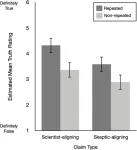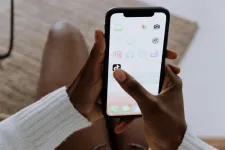(Press-News.org) Living less than about one-third of a mile from pesticide use prior to conception and during early pregnancy could increase the risk of stillbirths, according to new research led by researchers at the Mel and Enid Zuckerman College of Public Health and Southwest Environmental Health Sciences Center.
Researchers found that during a 90-day pre-conception window and the first trimester of pregnancy, select pesticides, including organophosphates as a class, were associated with stillbirth.
The paper, “Pre-Conception And First Trimester Exposure To Pesticides And Associations With Stillbirth,” was published in the American Journal of Epidemiology.
“In this study, some specific ingredients stood out due to their significant associations with stillbirth risk,” said first author Melissa Furlong, PhD, who studies the chronic health effects of environmental contaminants as an assistant professor and environmental epidemiologist at the Zuckerman College of Public Health and a member of the Southwest Environmental Health Sciences Center at the R. Ken Coit College of Pharmacy. “These findings underscore the importance of considering individual pesticides rather than just the overall pesticide class, as specific chemical compounds may pose unique risks. It also highlights the potential for pre-pregnancy exposures to affect reproductive outcomes.”
To conduct the study, researchers linked Arizona pesticide use records for 27 different pesticides with state birth certificate data that included 1,237,750 births and 2,290 stillbirths from 2006 to 2020.
They found that living within .31 miles (500 meters) of specific pyrethroid, organophosphate or carbamate pesticide applications during a 90-day pre-conception window or the first trimester was associated with an increased risk of stillbirth.
Specifically, the pesticides cyfluthrin, zeta-cypermethrin, organophosphates as a class, malathion, carbaryl and propamocarb hydrochloride were linked to increased stillborn births pre-conception. During the first trimester, fenpropathrin, permethrin, organophosphates as a class, acephate and formetanate hydrochloride were associated with stillbirths.
“Among organophosphates, acephate showed the strongest effect estimates on stillbirth, so that exposure to acephate in the first trimester was associated with a doubling of risk,” said co-author Paloma Beamer, PhD, a professor and interim associate dean at the Zuckerman College of Public Health and a member of the Southwest Environmental Health Sciences Center, U of A Health Sciences Asthma and Airway Disease Research Center and BIO5 Institute. “Within the pyrethroid class, cyfluthrin exposure during the 90 days prior to conception almost doubled the risk of stillbirth.”
Pesticides are chemical substances used to control pests in various settings. They are commonly categorized into different classes, such as organophosphates, pyrethroids and carbamates. The primary route of exposure for most people is through diet, but household use, agricultural drift and occupational exposure are also significant pathways.
Researchers say while some pesticides may not have been directly implicated in this study, they could still pose risks to maternal and fetal health.
Pregnant women may be particularly vulnerable to the adverse effects of pesticide exposure due to physiological changes during pregnancy, such as increased metabolic rate, altered hormone levels and changes in the immune system. The developing fetus may be more susceptible to the toxic effects of pesticides during this period of rapid growth and development.
“Further research is essential to fully understand the safety profiles of various pesticides and to understand the underlying mechanisms of pesticide-induced stillbirth,” Furlong said. “This study underscores the need to develop strategies for mitigating exposure to protect maternal and fetal health.”
Co-authors from the University of Arizona include Alfred Fournier, PhD, an associate specialist in entomology in the College of Agriculture, Life and Environmental Sciences; Peter Ellsworth, PhD, professor in the Department of Entomology at the College of Agriculture, Life and Environmental Sciences; Avelino Arrelano, PhD, an associate professor of data assimilation and atmospheric chemistry at the College of Science Department of Hydrology and Atmospheric Sciences; and Edward Bedrick, PhD, a professor in the Department of Epidemiology and Biostatistics at the Zuckerman College of Public Health. Other co-authors include Kimberly Parra, PhD, who was a doctoral candidate at the Zuckerman College of Public Health when the research was conducted and is now a research fellow at Harvard University’s T.H. Chan School of Public Health; Beate Ritz, MD, PhD, and Kimberly Paul, PhD, from the University of California, Los Angeles; and Myles Cockburn, PhD, from University of Southern California.
This research was supported in part by the National Institute of Environmental Health Sciences, a division of the National Institutes of Health, under Award Nos. R00ES028743 and P30ES006694.Living less than about one-third of a mile from pesticide use prior to conception and during early pregnancy could increase the risk of stillbirths, according to new research led by researchers at the Mel and Enid Zuckerman College of Public Health and Southwest Environmental Health Sciences Center.
Researchers found that during a 90-day pre-conception window and the first trimester of pregnancy, select pesticides, including organophosphates as a class, were associated with stillbirth.
The paper, “Pre-Conception And First Trimester Exposure To Pesticides And Associations With Stillbirth,” was published in the American Journal of Epidemiology.
“In this study, some specific ingredients stood out due to their significant associations with stillbirth risk,” said first author Melissa Furlong, PhD, who studies the chronic health effects of environmental contaminants as an assistant professor and environmental epidemiologist at the Zuckerman College of Public Health and a member of the Southwest Environmental Health Sciences Center at the R. Ken Coit College of Pharmacy. “These findings underscore the importance of considering individual pesticides rather than just the overall pesticide class, as specific chemical compounds may pose unique risks. It also highlights the potential for pre-pregnancy exposures to affect reproductive outcomes.”
To conduct the study, researchers linked Arizona pesticide use records for 27 different pesticides with state birth certificate data that included 1,237,750 births and 2,290 stillbirths from 2006 to 2020.
They found that living within .31 miles (500 meters) of specific pyrethroid, organophosphate or carbamate pesticide applications during a 90-day pre-conception window or the first trimester was associated with an increased risk of stillbirth.
Specifically, the pesticides cyfluthrin, zeta-cypermethrin, organophosphates as a class, malathion, carbaryl and propamocarb hydrochloride were linked to increased stillborn births pre-conception. During the first trimester, fenpropathrin, permethrin, organophosphates as a class, acephate and formetanate hydrochloride were associated with stillbirths.
“Among organophosphates, acephate showed the strongest effect estimates on stillbirth, so that exposure to acephate in the first trimester was associated with a doubling of risk,” said co-author Paloma Beamer, PhD, a professor and interim associate dean at the Zuckerman College of Public Health and a member of the Southwest Environmental Health Sciences Center, U of A Health Sciences Asthma and Airway Disease Research Center and BIO5 Institute. “Within the pyrethroid class, cyfluthrin exposure during the 90 days prior to conception almost doubled the risk of stillbirth.”
Pesticides are chemical substances used to control pests in various settings. They are commonly categorized into different classes, such as organophosphates, pyrethroids and carbamates. The primary route of exposure for most people is through diet, but household use, agricultural drift and occupational exposure are also significant pathways.
Researchers say while some pesticides may not have been directly implicated in this study, they could still pose risks to maternal and fetal health.
Pregnant women may be particularly vulnerable to the adverse effects of pesticide exposure due to physiological changes during pregnancy, such as increased metabolic rate, altered hormone levels and changes in the immune system. The developing fetus may be more susceptible to the toxic effects of pesticides during this period of rapid growth and development.
“Further research is essential to fully understand the safety profiles of various pesticides and to understand the underlying mechanisms of pesticide-induced stillbirth,” Furlong said. “This study underscores the need to develop strategies for mitigating exposure to protect maternal and fetal health.”
Co-authors from the University of Arizona include Alfred Fournier, PhD, an associate specialist in entomology in the College of Agriculture, Life and Environmental Sciences; Peter Ellsworth, PhD, professor in the Department of Entomology at the College of Agriculture, Life and Environmental Sciences; Avelino Arrelano, PhD, an associate professor of data assimilation and atmospheric chemistry at the College of Science Department of Hydrology and Atmospheric Sciences; and Edward Bedrick, PhD, a professor in the Department of Epidemiology and Biostatistics at the Zuckerman College of Public Health. Other co-authors include Kimberly Parra, PhD, who was a doctoral candidate at the Zuckerman College of Public Health when the research was conducted and is now a research fellow at Harvard University’s T.H. Chan School of Public Health; Beate Ritz, MD, PhD, and Kimberly Paul, PhD, from the University of California, Los Angeles; and Myles Cockburn, PhD, from University of Southern California.
This research was supported in part by the National Institute of Environmental Health Sciences, a division of the National Institutes of Health, under Award Nos. R00ES028743 and P30ES006694.
END
Pesticide exposure linked to stillbirth risk in new study
Increased rates of stillborn births were seen among people who lived near areas where pesticides were used during their first trimester of pregnancy or pre-conception.
2024-08-07
ELSE PRESS RELEASES FROM THIS DATE:
Individuals vary in how air pollution impacts their mood
2024-08-07
Affective sensitivity to air pollution (ASAP) describes the extent to which affect, or mood, fluctuates in accordance with daily changes in air pollution, which can vary between individuals, according to a study published August 7, 2024 in the open-access journal PLOS ONE by Michelle Ng from Stanford University, USA, and colleagues.
Individuals’ sensitivity to climate hazards is a central component of their vulnerability to climate change. Building on known associations between air pollution exposure and ...
Repetition boosts belief in climate-skeptical claims, even among climate science endorsers
2024-08-07
Climate science supporters rated climate-skeptical statements as “truer” after just a single repetition, according to a study published August 7, 2024 in the open-access journal PLOS ONE led by Mary Jiang from The Australian National University, Australia, and coauthored by Norbert Schwarz from the University of Southern California, USA, and colleagues. The results held true even for the strongest climate science supporters surveyed.
Amidst the influx of content that a person consumes each day, the principle of motivated ...
Study quantifies air pollution for NYC subway commuters
2024-08-07
New York City subway commuters who are economically disadvantaged or belong to racial minority groups have the highest exposure to fine particulate matter during their commutes, according to a new study published August 7, 2024 in the open-access journal PLOS ONE by Shams Azad of New York University, USA.
Fine particulate matter (PM2.5) is a type of air pollution that, due to its small size, when inhaled by a person can enter the bloodstream. PM2.5 is known to cause short- and long-term health complications. For the last few decades, cities have promoted public transportation to reduce traffic congestion and improve ambient outdoor air quality. Subway systems reduce pollution by decreasing ...
TikTok videos glamorizing disordered eating behavior and extremely thin body image ideals make women feel worse about their bodies
2024-08-07
Women who spend a lot of time on TikTok — especially those seeing a lot of pro-anorexia content — feel worse about their appearance, a new study shows. The results suggest that high TikTok exposure could harm mental health, reducing body image satisfaction and increasing the risk for disordered eating behavior. Madison Blackburn and Rachel Hogg from Charles Sturt University in Australia present these findings in the open-access journal PLOS ONE on August 7, 2024.
Since its launch, the short-form video app TikTok has had more than 2 billion downloads. The app’s algorithm curates content on a “For ...
Work-from-home success might depend on home office setup
2024-08-07
In a new survey study, Dutch employees who worked from home tended to report higher levels of productivity and less burnout if they were more satisfied with their home office setup. The study also linked more air ventilation in the home office to higher self-reported productivity. Martijn Stroom and colleagues at Maastricht University in the Netherlands report these findings in the open-access journal PLOS ONE on August 7, 2024.
In recent years, thanks in large part to the COVID-19 pandemic and technological advancements, ...
Trained dogs can sniff out CWD, a disease of major concern, in the droppings of farmed and wild deer, offering potential for non-invasive surveillance
2024-08-07
Trained dogs can sniff out CWD, a disease of major concern, in the droppings of farmed and wild deer, offering potential for non-invasive surveillance
###
Article URL: https://journals.plos.org/plosone/article?id=10.1371/journal.pone.0303225
Article Title: Biodetection of an odor signature in white-tailed deer associated with infection by chronic wasting disease prions
Author Countries: USA
Funding: TWRA AP-14839 Animal and Plant Health Inspection Service and WILDLIFE RESOURCES AGENCY, TENNESSEE https://www.aphis.usda.gov/aphis/ourfocus/business-services/financial-management-division/financial_services_branch/agreements_service_center/terms-conditions-for-aphis-awards ...
Ice cream made from mare's milk blended with cow's cream not only tastes good, but may have beneficial probiotic qualities
2024-08-07
Ice cream made from mare's milk blended with cow's cream not only tastes good, but may have beneficial probiotic qualities
###
Article URL: https://journals.plos.org/plosone/article?id=10.1371/journal.pone.0304692
Article Title: The use of mare’s milk for yogurt ice cream and synbiotic ice cream production
Author Countries: Poland
Funding: The author(s) received no specific funding for this work. END ...
Indian business owners from the stigmatized Dalit group experience a business income gap of around 16% compared to others
2024-08-07
Indian business owners from the stigmatized Dalit group experience a business income gap of around 16% compared to others
###
Article URL: https://journals.plos.org/plosone/article?id=10.1371/journal.pone.0307660
Article Title: It’s not who you know, but who you are: Explaining income gaps of stigmatized-caste business owners in India
Author Countries: India, UK, Australia
Funding: The author(s) received no specific funding for this work. END ...
International Space Station crew carries out first-ever archeological survey in space
2024-08-07
An archaeological strategy adapted for space used daily photos to reveal how astronauts actually use areas aboard the International Space Station – and how this differs from intended uses. Justin Walsh of Chapman University, California, and colleagues present these findings in the open-access journal PLOS ONE on August 7, 2024.
More than 270 people from 23 countries have visited the International Space Station (ISS) over more than two decades. Crew member interviews can reveal how people adapt to a novel environment—one featuring isolation, confinement, and microgravity—that is far removed ...
Electric bandage holds promise for treating chronic wounds
2024-08-07
Researchers have developed an inexpensive bandage that uses an electric field to promote healing in chronic wounds. In animal testing, wounds that were treated with these electric bandages healed 30% faster than wounds treated with conventional bandages.
Chronic wounds are open wounds that heal slowly, if they heal at all. For example, sores that occur in some patients with diabetes are chronic wounds. These wounds are particularly problematic because they often recur after treatment and significantly increase the risk of amputation and death.
One of the challenges associated ...
LAST 30 PRESS RELEASES:
Australian team discover why quantum computers have memory problems over time
What determines the fate of a T cell?
Candida auris: genetic process revealed which could be treatment target for deadly fungal disease
Groundbreaking discovery turns household plastic recycling into anti-cancer medication
Blocking a key inflammatory pathway improves liver structure and vascular function in cirrhosis, study finds
Continuous spread: Raccoon roundworm detected in nine European countries
HKUST Engineering researchers developed a novel photodetector to enhance the performance of on-chip light monitoring
Strategic river sensors could have forewarned of Texas Camp flood disaster
Drone sampling of whale breath reveals first evidence of potentially deadly virus in Arctic
Roman soldiers defending Hadrian’s Wall infected by parasites, study finds
Pinochet’s prisoners were tormented with music but still found solace in it, a new book reveals
Fertility remains high in rural Tanzania despite access to family planning
AI-assisted device can improve autism care access
Kinetic careers
Uncovering how parasitic plants avoid attacking themselves to improve crop resistance
Nanoparticle vaccine strategy could protect against Ebola and other deadly filoviruses
Study finds brain care score can predict risk of stroke across racial groups
Key lung immune cells can intensify allergic reactions
Do hormones explain why women experience more gut pain?
New materials conduct ions in solids as easily as in liquids
Breakthrough of the Year: Renewable energy begins to eclipse fossil fuel-based sources
LLM use is reshaping scientific enterprise by increasing output, reducing quality and more
Introducing LightGen, a chip for ultra-fast, ultra-efficient generative AI
Astronomers see fireworks from violent collisions around nearby star
ACC/AHA issue new guideline on managing congenital heart disease in adults
Cosmic crash caught on camera
Is talented youth nurtured the wrong way? New study shows: top performers develop differently than assumed
Ants: An untapped resource in the development of antibiotics?
Archaeologists use AI to create prehistoric video game
Mitochondria migrate toward the cell membrane in response to high glucose levels
[Press-News.org] Pesticide exposure linked to stillbirth risk in new studyIncreased rates of stillborn births were seen among people who lived near areas where pesticides were used during their first trimester of pregnancy or pre-conception.










